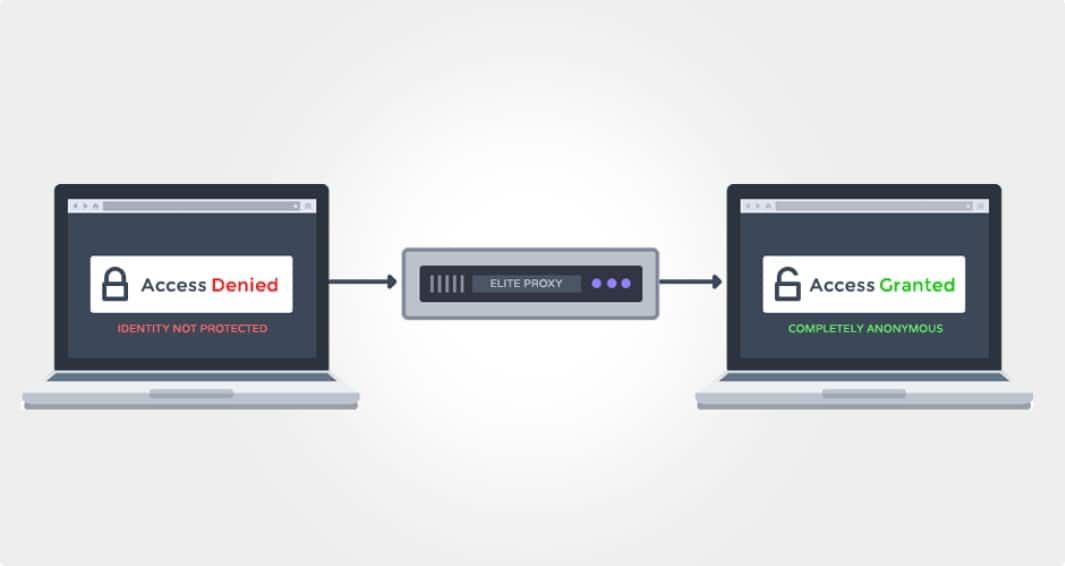
It’s a bit of a guessing game as to who is reading this: proxy users, or entities that want to stop proxy use.
Typically when anyone wants to detect whether or not an IP is a proxy it’s because they’re trying to make a decision about cutting off access to the said proxy, and therefore the person who is using the proxy.
Is that your intention? If so, that’s fine.
However, know that this article is more about giving tools to proxy users (not blockers) in order to get a deeper understanding of the technology they are using, and running their own tests on free proxies and proxy providers.
I say that specifically because I support the use of proxies, and in no way feel that they should be blocked outright by a company.
Detecting that IP Address
With that said, it is important to discuss why a proxy user would want to check in on certain IP addresses.
Free Proxies
The most common reason is to ascertain how legitimate a free proxy is. Beyond checking for the anonymous, transparent, or elite levels, it’s important to see what kind of agent user is being used (see below), and where the proxy comes from originally. If you’re going to use a free proxy, knowing where it comes from is a good idea.
Residential vs. Datacenter Proxies
The second major reason is to check in on services that are selling specific kinds of proxies, especially “residential”. There are countless businesses rotating residential proxies for sale when in reality they’re using datacenter proxies that are well-hidden.
Knowing the difference is key because it could save you a lot of money and call out a business on their integrity.
Other Research
You might not be a company, yet still want to know more about proxies and conduct research on the number and type available by different companies. Getting a handle on whether or not the IP is actually a proxy, and what type of proxy it is, is very valid.
All of this will be explored below through specific detection scenarios.
Five Ways to Detect if an IP is a Proxy
1. Web Applications
The first major way to get a cursory idea of whether or not an IP address is a proxy (and other details about it) is through a web application.
These are typically free tools developed by companies that want you to visit their website, sign up for their semi-related service, or click on some sort of affiliate link. You don’t have to do any of those things, and you can usually still use the free tool, which is nice.
There are also paid web applications, but I won’t go into those here because you likely don’t need something that complex and powerful (not to mention expensive).
The free web applications will:
- Check your current IP address (whatever that may be) and tell you if they think it’s a proxy or not.
- Tell you the ISP and organization's name.
- Tell you the IP host’s name.
- Tell you the country the IP is in.
- Tell you the region or state the IP is in.
- Provide the best guess of the city the IP is in.
- Guess the latitude and longitude of that location.
That’s a lot of information for a simple look-up. It makes sense, viewing all that, why someone would want to use a proxy in the first place. If you aren’t using one, all of that information points clearly to where you are and who you buy your internet from. Based on the above information the service will determine whether or not the IP address is a proxy, and let you know.
I use WhatIsMyIPAddress Proxy Checker for this — it’s simple, straightforward, and not cluttered with advertising. Going there will specifically check the proxy your computer or device is using.
If you want to check another IP address (not one you’re using) their IP Lookup is also great. You can enter in any IP address there and get the same information. However, you’ll have to understand some more about proxies and IP addresses, which leads to the steps below.
2. Location
One of the biggest ways to determine whether or not an IP address is actually a proxy is to use a check like the one above and center in on the location. Where does the check say the proxy is located? Does that place seem realistic for an individual to live and purchase internet, or not?
The answers to these questions can vary quite a bit, so it’s important to understand the framework behind the question.
Proxies are split down two main ways: datacenter and residential. I touched on these above; they play a critical role in how well a proxy function, and whether or not it is actually a proxy or not.
Residential means, literally, that the IP address is associated with an individual house, paying user, and Internet Service Provider (ISP). Datacenter means the IP address was created in a large server center, and was pumped out along with hundreds of thousands of other IP addresses, all of which will be used as proxies.
One of the main ways you can determine an IP address proxy status is through the location that a lookup brings.
Data centers, or server centers, are usually in large, flat places where one could build a massive warehouse of computers. In the U.S., that means places like Nebraska, Kansas, and Iowa. Yes, there are dedicated datacenters everywhere (and in most states), but commonly they are in the middle of the U.S.
Given that the lookup even provides cities and latitude/longitude coordinates you can narrow in on whether or not the IP address looks like it is owned and used by an individual in a house, or some large center out in a field.
IP data for location:
Outside Your Country
The other version of this is if you’re looking up a proxy that is outside of your country. It’s a common practice to get and use proxies from all over the globe in order to bypass geolocation.
So, if you find an IP address is in Norway, for instance, it’s probably a data center proxy. This is harder to determine, but most of the time you can bet that an IP address used in a country outside of your own is a proxy, unless specifically advertised otherwise.
IP Address 101: What Is Your Real Public IP address?
3. Look at the Internet Service Provider
Building on the above method, you would next look at the Internet Service Provider (ISP). This information also comes from the IP lookup, and is a more sure way of telling if the IP address is a proxy or not.
Basically, the ISP of an IP address is whoever manufactures and owns that IP. In the U.S. common ISPs are Comcast, Time Warner Cable, Spectrum, Cogent, AT&T, etc. Basically, large corporations that you call to install internet in your home. In order to install the said internet, they have to give you an IP address, which is your IP.
In other countries, this would still be true, but the companies would be different. When looking at the information provided in a lookup, see what is listed for the “ISP” or “Organisation”. Is it a recognized provider of the Internet in your country?
Or is it a corporation with a name that includes the words “server”, “cache”, “host”, “proxy”, etc.?
If it’s a corporation that doesn’t ring a bell, it likely means the IP address is owned and manufactured by a proxy company, and is typically in a data center somewhere.
This is the most reliable method of determining whether or not an IP address is a proxy right off the bat.
Two of the most common proxy hostnames are OVH and Hostgator, but there are tons of them.
Also, ISPs or ASNs with a smaller number of IPs allocated to them are more likely to be detected as a proxy server.
IP Data for ASN, and ISP,
4. Inspect the User-Agent
Moving away from the specifics of a lookup you can inspect an IP addresses’ user agent.
A user agent is a set of identifying factors that any IP address sends along to a website. It includes information like the OS of your computer and the browser you’re using, specifically what versions.
This allows websites to send the most up to date graphics and coding back to the user, making your web browsing experience seamless.
That’s only true when it’s your normal ISP IP address. A proxy has the ability to change the user agent, either manually or through pre-sets via a proxy provider.
A good way to check whether or not an IP address is a proxy is to inspect the user agent and look for outdated or strange things. If the IP is showing a version of Internet Explorer from four years ago, it’s unlikely it’s a real person, because that version would have been updated by now. The same goes for an OS system, too.
How to Inspect the User-Agent
Much like the web applications that check your IP information in terms of location and host, there are free tools that check your IP’s user agent.
UserAgentString is one of the best tools because it gives you a detailed breakdown of what all the different aspects of user agents mean. It checks the IP address you’re currently using to reach the site, which means you’d have to load the questionable IP address into your browser, then visit to check on its user agent.
If it presents a bunch of information that’s not true about your computer, it’s a proxy.
You can use AtomURL to view your ISP IP user agent string, or you can enter in any proxy to check its user agent string.
However, this is not a full-proof method, because many proxies don’t alter the user agent on their own. A good proxy won’t, because altering the user agent can significantly change what you’re viewing on a web page, which you may not want.
This means you should use this step in conjunction with the others to get a fuller picture of the IP address in question.
You can change your user agent string with User Agent Switcher, but that’s getting more into the use of your proxies, rather than identifying them.
5. Inspect Time on Page and Pages Visited
The governing principle of using proxies is to keep them looking like a human. People do this so those proxies won’t get banned or blocked by Google and other search engines; these engines are designed for use with humans, not machines.
The most common scenario of a proxy failing to do this is when it inspects a website’s pages, and how many pages it visits. If it looks at a web page for 2 seconds (not a typo) and visits 1,000 pages in under a minute, it’s a proxy.
No human could do that, even if they had a robotic hand and a lot of coffee. It’s just not possible to click that fast.
You can use this rubric to determine if an IP address has been speed walking through the internet, thereby identifying itself as a proxy. If it hasn’t been, it might just be a normal ISP IP.
How to Inspect Time on Page and Pages Visited
The actual How To of this is more complicated than the idea. It depends if you have access to the IP address, if you’re looking at the IP address from the outside, and if you have a specific internal network that can monitor usage.
It’s easy to monitor your own usage of an IP address, but in that case, you would likely know if it’s a proxy or not. I don’t recommend using a tool like Scrapebox to increase time on page and pages visited just to see if the IP address is a proxy — it either is, and will get banned, or it’s not, and will get banned. Both are negative, the latter could lead to trouble with your ISP.
If you have a website and want to understand more about an IP address that comes to your site, you can look up usage stats in analytics panels, like Google Analytics or others. In there you can see an IP address that has been logging a large volume of page visits with short times, and then do the rest of the research to see if it’s a proxy or not. Again, any activity that’s not possible by a human means it’s a proxy, not a superhuman.
BTW, crazyegg.com is a great heatmap and A/B testing tool that records user action on your website, you can easily review records of user actions.
Wrapping Up
The five methods above are all fairly easy, free ways to check on the nature of an IP address. Whatever your reasons for wanting to know if it’s a proxy, these will help.
It’s best to take a critical view of all of them together, painting a large picture of what the IP address is doing, how it’s doing it, and where it’s doing it from, and then decide whether or not it’s a proxy.
Related:






